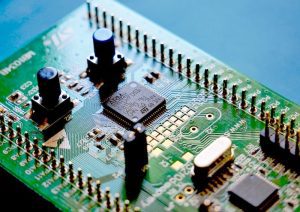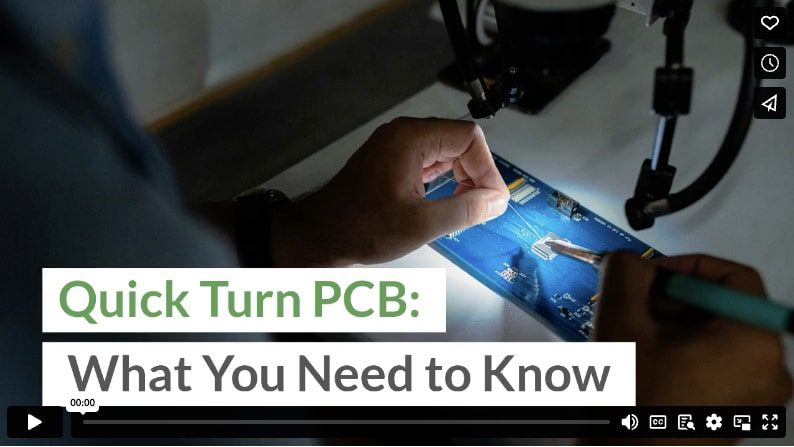Printed Circuit Boards (PCBs) are an integral part of modern technology. Without them, many of the devices we use daily will not function. Due to the massive turnover inherent with these products, the industry has made efforts to speed up PCB production. We refer to this as quick turn PCB manufacturing.

(Vishnu Mohanan/unsplash)
What is Quick Turn Manufacturing?
Quick turn manufacturing uses the quickest method for PCB assembly without compromising board quality. It presents an ideal solution for quickly producing several boards with minimal errors – you can use quick turn manufacturing to fill large orders in as little as seven days.
The method first came about from prototype production systems. Engineers would throw together a mock-up of an intended PCB design and build it rapidly to present a basic idea of the final product. Because a prototype doesn’t require the same intensive accuracy and testing as the final product, manufacturers deemed the practice acceptable.
Over time, manufacturers and assemblers discovered that by utilizing modern advances in PCB production, they could achieve greater degrees of accuracy with the prototype building process. They could assemble the final PCB design to acceptable working conditions by applying stringent guidelines to these procedures. This, coupled with mass-production plans, made it possible to produce high volumes of fully-function PCBs in a much shorter period.
The average fabrication process can be completed within 1 to 7 days with quick turn PCB manufacturing – half the time of the standard processes. The following criteria affect the timeline:
- Board size and component layout
- Surface finish
- Number of layers
- Surface Mount Technology (SMT) requirement
- Through hole assembly
- Lamination
All of these will affect the production time for any board. But a well-qualified and practiced assembler can adapt these components to a quick turnaround schedule. This is ideal for products that manufacturers must build on a tight schedule to keep development time down and shareholders happy.
We stress, however, that a manufacturer should be well-versed in the processes of quick turn manufacturing before attempting to do it. The objective here is to build PCBs quickly and efficiently and meet all the quality goals required of the board. Most manufacturers are better suited to standard production times, so when seeking a quick turn option, always consider the company’s experience with the process.
The Benefits of Quick Turn Manufacturing
As the name implies, quick turn manufacturing offers the advantage of being much quicker than standard manufacturing processes. Cutting down on processing and assembly times allow manufacturers to build fully functional PCBs with much more efficiency and speed.
The second main benefit of quick turn manufacturing is its reduced cost. The shorter manufacturing times are inherently more cost-effective than longer ones. This, coupled with reliable components, makes quick turn manufacturing the de-facto choice for time-sensitive, large-volume PCB production.
The Design
Quick turn manufacturing begins with the PCB design plans, which are sent to the chosen manufacturer in a Gerber file format. Gerber is the industry standard and is sent to the manufacturers via email. The manufacturer will then review the design and ensure it meets the design requirements and IPC standards. This is called a Design for Manufacturability (DFM) review and will be followed by a quote if approved.
Prototype
Next, the PCB designer will create a mockup so they can test the board before carrying out mass production. This allows design edits to be implemented before mass-production causes a large loss in time and money, streamlining the process before it even begins. By testing component layout and overall design before production, manufacturers will find potential errors or design improvements ahead of time.
Prototypes also allow manufacturers to present an example of the product to their clients, giving them a chance to offer any feedback or changes themselves. This keeps both client and manufacturer in the loop as the PCBs are constructed. Plus, it helps manufacturers eliminate any potential for errors or miscommunication further down the line.
Beta-run
Once the prototype is approved, designers create a batch of beta boards using the accepted specifications for testing purposes. Typically, a batch will be between a few hundred and several thousand boards, all built to represent the final product. If the client has any further changes they wish to make with the PCB design, now is the time to make them.
If any issues occur during this stage – either from the original designs or the corrections done during the prototype stage, you should rectify them before final production begins. At this point, manufacturers conduct full testing on every aspect of the board, highlighting any structural, layout, or component issues that the design has. If everything is correctly assembled and the components work as they should, it will be ready to move on to the final production stage.
Full Production
With the final PCB design set in stone, mass production begins. With the plans set, assembly machines quickly churn out the desired number of fully-formed boards. This can be done as quickly as the production machinery will allow, as the manufacturers can be sure that there will be no errors in the final product. Large-quantity production is ideal when every board member is in its most ideal and functional place.
While these steps will involve other kinds of manufacturing, the speed with which trained professionals accomplish them is what makes quick-turn manufacturing so valuable. It takes a PCBA manufacturer dedicated to the art of PCB production, with a strong understanding of the processes and techniques involved, to speed up a lengthy and precise industry like PCB production. Therefore it is important to seek out companies with great track records.
Many situations require companies to seek faster and cheaper means of production. Fortunately, PCB manufacturing is an industry that has seen phenomenal advances in techniques and technology that help customers to this end. When you’re looking for a way to acquire PCBs in a short time frame, quick turn PCB manufacturing represents the best solution.
Infographic
With the massive turnover of Printed Circuit Boards (PCBs), manufacturers had come up with quick turn PCB manufacturing. It is the fastest method to meet large-volume and time-sensitive PCB production. Can it produce quality boards? How long will it take? What goes into the process? Find the answer to these questions in this infographic.

Video

